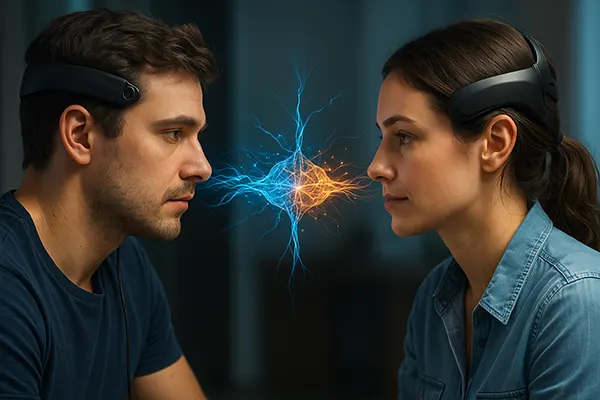Neurocommunication Between Humans via AI: The First Steps Towards Future Telepathy

In early 2025, a shift in communication has begun — not in science fiction novels, but in real-world laboratories and technological hubs. The integration of artificial intelligence into human cognitive exchange has taken a monumental leap forward. While classic verbal and digital communication still dominate, emerging neurotechnologies are already forging new pathways for mind-to-mind interaction.
Understanding Neurocommunication Through AI
Neurocommunication refers to the transmission of information directly between brains, bypassing spoken or written language. Until recently, this concept belonged to the realm of speculative neuroscience. However, with recent advancements in AI, brain-computer interfaces (BCIs), and neural decoding, the idea of digitally-assisted thought exchange is becoming viable.
Leading research institutions, such as the University of California, Berkeley, and the Neuralink initiative, have developed neural devices that decode brain activity into words and images. In one 2023 study, AI algorithms reconstructed silent thoughts into coherent text with over 75% accuracy. This breakthrough suggests we are on the verge of direct mind-to-mind messaging, assisted by intelligent decoding systems.
Key components of this advancement include electroencephalography (EEG), functional magnetic resonance imaging (fMRI), and machine learning algorithms. When combined, these technologies allow machines to ‘read’ mental signals and interpret them with growing precision. As AI becomes more contextually aware, the accuracy and richness of these translations will improve, setting the stage for the next evolution of communication.
Scientific Milestones Enabling Thought-Based Interaction
In 2024, researchers achieved a major milestone by enabling a paralysed patient to communicate at natural speech speed using an AI-augmented BCI. This system decoded neural patterns from the brain’s motor cortex and transformed them into spoken words on a screen. It was the first time a speech prosthesis reached real-time conversation speeds.
Simultaneously, AI-driven experiments with non-invasive BCIs are showing promise. Companies like Synchron and NextMind are developing tools that do not require brain implants, expanding access to wider populations and reducing medical risks. Their AI-powered interfaces can already interpret basic commands and expressions.
As we transition into 2025, cross-disciplinary cooperation between neuroscientists, AI engineers, and ethicists is accelerating progress. The convergence of neuroscience and artificial intelligence is creating tools capable of capturing and translating abstract human thoughts into structured information with a degree of fidelity never before imagined.
AI-Mediated Empathy and Human Connection
One of the most profound potentials of neurocommunication lies in its emotional dimensions. AI models trained on emotional datasets can now identify and mirror a person’s feelings through neural patterns. This allows for more meaningful, context-rich communication, even in the absence of verbal cues.
In therapy settings, AI-powered BCIs have been piloted to help patients with severe speech or motor impairments express needs and emotions. These tools not only improve quality of life but also open ethical conversations about autonomy and consent in digitally-mediated interaction.
Moreover, educational and collaborative scenarios benefit from AI-enhanced understanding of emotional states. When paired with brain-signal monitoring, AI can identify confusion or cognitive overload and adapt content delivery in real-time, optimising both empathy and efficiency in human connection.
Applications in Mental Health and Social Cohesion
Neurocommunication is finding early application in mental health diagnostics. AI trained on neural data can detect markers for anxiety, depression, or PTSD, sometimes earlier than traditional methods. This opens the door for preemptive intervention and personalised care pathways.
Beyond medicine, researchers are exploring AI-mediated group synchronisation in social settings. Pilot studies show that shared neural states, guided by AI, can enhance team performance and collective focus in educational and professional environments.
The ethical use of such tools hinges on transparency and consent. Human-to-human connection, while enhanced by AI, must still preserve agency, privacy, and the authenticity of emotion. Ensuring AI acts as a facilitator — not a filter — is essential for the technology to serve communal rather than exploitative ends.

Challenges and the Road Ahead
Despite the enthusiasm surrounding AI-driven neurocommunication, the path ahead is layered with technical, ethical, and philosophical challenges. Privacy remains a dominant concern. If thoughts can be decoded, who controls that information? How can society protect inner cognition from misuse?
Another hurdle lies in the accuracy and inclusivity of AI algorithms. Much like early voice recognition tools, neurocommunication models can carry biases, especially when trained on limited or homogeneous datasets. Ensuring equitable access and fair design will be a defining challenge for the coming decade.
On the technological side, high-fidelity brain decoding still requires bulky and expensive equipment. Making the tools more portable, accessible, and adaptable to individual neurodiversity will be key to broader adoption. While invasive methods yield higher accuracy, non-invasive paths are more scalable but currently limited in resolution.
The Next Decade of Thought-Driven Interaction
By 2030, it is expected that AI-assisted neurocommunication will find standard use in certain fields — particularly healthcare, defence, and advanced computing. In everyday life, it may become a tool for accessibility, enabling individuals with neurological impairments to participate more fully in society.
Researchers are also exploring cross-species neurocommunication, where AI mediates between human and animal cognition. These experiments could revolutionise animal welfare, training, and even interspecies understanding.
Although full-scale telepathy as envisioned in science fiction remains distant, the groundwork laid in 2024 and 2025 signals the start of a long journey. With responsible development, neurocommunication may one day allow humans to connect not just through words, but through shared experience and intent, fundamentally reshaping what it means to communicate.


